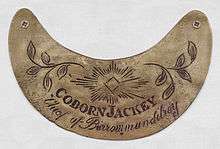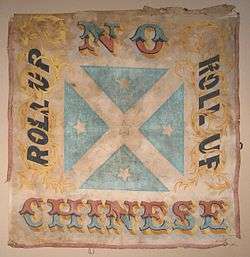Young, New South Wales
| Young New South Wales | |||||||||
|---|---|---|---|---|---|---|---|---|---|
|
Young courthouse built in 1884 but transferred to the Department of Education in 1925 and used as the main hall of Young High School | |||||||||
 Young | |||||||||
| Coordinates | 34°18′0″S 148°18′0″E / 34.30000°S 148.30000°ECoordinates: 34°18′0″S 148°18′0″E / 34.30000°S 148.30000°E | ||||||||
| Population | 6,960 (2011 census)[1] | ||||||||
| Established | 1826 | ||||||||
| Postcode(s) | 2594 | ||||||||
| Elevation | 439 m (1,440 ft) | ||||||||
| Location | |||||||||
| LGA(s) | Hilltops Council | ||||||||
| State electorate(s) | Cootamundra | ||||||||
| Federal Division(s) | Riverina | ||||||||
| |||||||||
Young is a town in the South West Slopes region of New South Wales, Australia and the largest town in Hilltops Council. At the 2011 census, Young had a population of 6,960.[1]
Young is marketed as the Cherry Capital of Australia and every year hosts the National Cherry Festival. Young is situated on the Olympic Highway and is approximately 2 hours drive from the Canberra area. It is in a valley, with surrounding hills. The town is named after Sir John Young, the governor of NSW from 1861 to 1867.[2]
History

Before European settlers arrived in Young, members of the Burrowmunditory tribe, a family group of the Wiradjuri people, lived in the region.[3] Descendents of the Burrowmunditory clan still live in Young.[4]
James White was the first European settler in the district and established Burrangong Station in 1826 with a squatting claim of 260 square kilometres (100 sq mi).[3] His story is told in the novel Brothers in Exile. Gold was found in the district in 1860. Until that time the area was called Lambing Flat, a reference to the grazing of sheep that was the main industry until mining. The town was gazetted in 1861. The goldfields produced 15,000 kilograms (470,000 ozt) of gold sent by escort from the fields. Up to 20,000 miners worked the fields including about 2,000 Chinese miners.[3]
Lambing Flat Post Office opened on 1 March 1861 and was renamed "Young" in 1863.[5]
From November 1860 through to June 1861, anti-Chinese miners attacked Chinese gold miners in the area, now known as the infamous Lambing Flat riots. As gold became scarce, European miners began to resent what they saw as the greater success of the more industrious Chinese, and hence many Chinese miners were attacked, robbed and killed. The anti-Chinese rebels rallied in numbers of up to 3,000. Eventually the rioters were controlled, Chinese miners had their claims restored to them, but the New South Wales Parliament passed the Chinese Immigration Bill which restricted the number of Chinese that could be brought into New South Wales on any ship and imposed a tax per head on entry.
In 1889 Young was the first town in Australia to install electricity into the streets and homes of the township, Tamworth NSW installed electricity to the streets only the previous year.
The former Young Shire was acknowledged as the first Local Government Area to institute a rural school bus system in New South Wales.[3]
Climate
Young has a humid subtropical climate (Cfa).[6]
| Climate data for Young Airport | |||||||||||||
|---|---|---|---|---|---|---|---|---|---|---|---|---|---|
| Month | Jan | Feb | Mar | Apr | May | Jun | Jul | Aug | Sep | Oct | Nov | Dec | Year |
| Record high °C (°F) | 42.6 (108.7) |
42.0 (107.6) |
38.6 (101.5) |
32.6 (90.7) |
25.4 (77.7) |
21.9 (71.4) |
19.9 (67.8) |
23.6 (74.5) |
26.9 (80.4) |
34.4 (93.9) |
42.1 (107.8) |
41.1 (106) |
42.6 (108.7) |
| Average high °C (°F) | 31.7 (89.1) |
30.4 (86.7) |
27.2 (81) |
22.7 (72.9) |
17.8 (64) |
13.9 (57) |
12.9 (55.2) |
14.6 (58.3) |
17.8 (64) |
21.9 (71.4) |
26.1 (79) |
29.1 (84.4) |
22.2 (72) |
| Average low °C (°F) | 14.6 (58.3) |
14.7 (58.5) |
11.1 (52) |
6.6 (43.9) |
3.3 (37.9) |
2.4 (36.3) |
1.1 (34) |
1.3 (34.3) |
3.1 (37.6) |
5.3 (41.5) |
9.3 (48.7) |
11.8 (53.2) |
7.0 (44.6) |
| Record low °C (°F) | 1.4 (34.5) |
2.3 (36.1) |
0.4 (32.7) |
−4.1 (24.6) |
−5.8 (21.6) |
−6.1 (21) |
−7.0 (19.4) |
−6.5 (20.3) |
−5.5 (22.1) |
−4.7 (23.5) |
−2.4 (27.7) |
−0.2 (31.6) |
−7.0 (19.4) |
| Average precipitation mm (inches) | 41.0 (1.614) |
51.4 (2.024) |
46.2 (1.819) |
31.5 (1.24) |
40.0 (1.575) |
64.1 (2.524) |
60.9 (2.398) |
51.0 (2.008) |
54.4 (2.142) |
45.9 (1.807) |
64.0 (2.52) |
57.8 (2.276) |
589.7 (23.217) |
| Average precipitation days | 6.7 | 7.3 | 6.9 | 5.7 | 9.6 | 14.9 | 17.5 | 14.7 | 11.6 | 9.1 | 8.5 | 7.1 | 119.6 |
| Source: [7] | |||||||||||||
Demographics
On census night, 7 August 2001, there were 6,821 people (3,287 males and 3,534 females) counted in Young. There were 238 people (1.221%) (127 males and 111 females) who identified as being of Indigenous origin in the 2001 Census. The median age of people in the 2001 Census was 36 years
The number of people born overseas in the 2001 Census was 650 (5.8%) compared with 589 (5.3%) in the 1996 Census and 549 (5.1%) in the 1991 Census. Of those born overseas, the three main countries of birth in the 2001 Census were:
- United Kingdom: 253 (2.2%)
- New Zealand: 74 (0.7%) and;
- Netherlands: 34 (0.3%).
In the 2001 Census, the three most common ancestries identified with were:
- Australian: 5741 people (50.9%)
- English: 4022 people (35.7%) and;
- Irish: 1309 people (11.6%).
English was stated as the only language spoken at home by 10547 people (92.6%) in the 2001 Census. The three most common languages spoken at home other than English in the 2001 Census were:
- Arabic (including Lebanese): 130 (1.8%)
- Dutch: 24 (0.2%) and;
- Chinese: 20 (0.2%).
In the week preceding the 2001 Census, 3333 people (29.6%) had used a personal computer at home. 407 (4.8%) people (154 males and 253 females) held a bachelor's degree. 6140 (72.1%) people (2775 males and 3365 females) did not have a qualification. 349 people (194 males and 155 females) were unemployed, representing 7.1% of the labour force. The median weekly individual income for people aged 15 years and over in the 2001 Census was $300–$399. In the 2001 Census, there were 3847 separate houses (89.0%), 141 semi detached, row or terrace houses and townhouses (3.3%), 227 flats, units or apartments (5.3%) and 97 other dwellings (2.2%). In the 2001 Census, there were 1378 couple families with children (which comprised 45.6% of all families in occupied private dwellings), 1149 couple families without children (38.1%), 445 one parent families (14.7%) and 47 other families (1.6%).
The Lambing Flat Chinese Tribute Gardens

Young Shire Council has established these gardens adjacent to the site of Chinamans Dam, which is an old railway dam about 4 km south of Young. They are intended to create an ambience similar to the Japanese Gardens at Cowra. Chinamans Dam, with an initial capacity of over 9,100 cubic metres (2×106 imp gal) when it was in railway use, is situated at a very small place called Pitstone on Sawpit Gully. The story goes that the dam was built in the 1860s by Dutch brothers, Herman and John Tiedemann, to provide water for the sluicing of their Victoria Hill gold claims. At some time in the 1870s, the brothers sold the area, including the dam, to a Chinese group who worked the site.
The story of the dam as a railway facility began in 1882 when the NSW Railway Commissioners gave notice of the intention to build the first part of the Blayney-Demondrille railway. To provide water for its steam locomotives, the Commissioners decided to provide a dam and pump water from it to a facility, known as Young Tank, at the 396-kilometre (246 mi) post. It is not known whether the railways enhanced the existing dam or built a new facility.
From 1885 to 1901, locomotives stopped at Young Tank to replenish their water. In 1901, watering facilities were built at Young Station. The supply of water was obtained from Chinamans Dam. The capacity of the dam was enlarged in 1911.
The dam was a popular spot for swimming. Whilst officially frowned upon, it was tolerated.
Following the connection to the South West Tablelands Water Supply Scheme, which provided water from Burrinjuck Dam, the railways ceased to draw water from Chinamans Dam after 1936. The site was returned to the Crown in 1962 and in the following year, a 15-hectare (36-acre) reserve was established and the Shire Council appointed as Trustees. The dam has since been enlarged.[8]
Education
Young has six schools:
- St Mary's Primary School
- M-E-T School Young Campus
- Young North Primary School
- Young Public School
- Hennessy Catholic College
- Young High School
Sport
The town's rugby league team competed for the Maher Cup.
- Young Yabbies is a rugby union team playing in the Southern Inland Rugby Union competition.
- Young Cherrypickers is a rugby league team playing in the Group 9 competition
- Young Saints is an Australian football team playing in the Central West AFL competition.
- Young Lions is a soccer club fielding teams that play in the Bathurst District Soccer Senior Men's and Senior Women's competition.
Media
Newspapers
- Burrangong Argus 1864-1914 (became the Young Witness)
- Burrangong Chronicle 1873-1902 (became the Young Chronicle)
- Burrangong Courier 1962 (ceased publication)
- The Lambing Flat Miner 1862-1961 (ceased publication)
- Young Chronicle 1902-1947 (incorporated in The Young Witness)
- The Young Witness 1914-
Radio stations
- ABC Classic FM 88.3
- ABC Radio National 89.1/97.1
- ABC Riverina 89.9/96.3
- Roccy FM 93.9 (commercial)
- SBS Radio FM 98.7 (retransmission)
- triple j 90.7
- 2LF AM 1350 (commercial)
- 2YYY (community radio)
Notable people
- Peter Cusack, Rugby League Footballer
- Ron Lynch, Rugby League Footballer and coach
- Nathan Lyon, Australian cricketer
- Roger McDonald, author
References
- 1 2 Australian Bureau of Statistics (31 October 2012). "Young (Urban Centre/Locality)". 2011 Census QuickStats. Retrieved 1 November 2012.

- ↑ "Young". Geographical Names Register (GNR) of NSW. Geographical Names Board of New South Wales. Retrieved 30 July 2013.
- 1 2 3 4 "History". visityoung.com. Retrieved 2007-02-09.
- ↑ "New beginning". The Young Witness. Fairfax Media. 12 July 2013. Archived from the original on 25 April 2014.
- ↑ Premier Postal History. "Post Office List". Premier Postal Auctions. Retrieved 2011-05-26.
- ↑ R.L. Specht; Philip Rundel; W.E. Westman; P.C. Catling; Jonathan Majer; Penelope Greenslade (6 December 2012). Mediterranean-type Ecosystems: A data source book. Springer Science & Business Media. p. 95. ISBN 978-94-009-3099-5.
- ↑ "Climate statistics for Young Airport". Bureau of Meteorology. Commonwealth of Australia. Retrieved 21 December 2016.
- ↑ Chinaman's Dam Young Sharp, Stuart Australian Railway Historical Society Bulletin, January, 2002 pp3-8
External links
![]() Media related to Young, New South Wales at Wikimedia Commons
Media related to Young, New South Wales at Wikimedia Commons